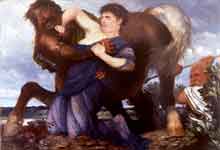Hercules slaying the Centraur Nessos (or Nessus), Stamp Greece, 1970. Painting of a 1.22 m Early Black-Figure / Late Protoattic Aphora (Nessos Amphora), National Museum of Athens (NM1002). Discovered 1890 in Athens (at the Kerameikos region), the unknown artist named as the "Nessos painter".
In Greek mythology, Nessus (Greek Νέσσος) was a famous centaur who was killed by Heracles, and whose tainted blood in turn killed Heracles. He was the son of Ixion and Nephele, the Cloud.
He fought in the battle with the Lapiths. He became a ferryman on the river Euenos.
Nessus is known for his role in the story of the Tunic of Nessus. After carrying Deianeira, the wife of Heracles, across the river, he attempted to rape her. Heracles saw this from across a river and shot a Hydra-poisoned arrow into Nessus's breast. As a final act of malice, Nessus told Deianira, as he lay dying, that his blood mixed with his semen would ensure that Heracles would be true to her forever.
Heracles and Nessus, Louvre K537
Deianira foolishly believed him. Later, when her trust began to wane, she spread the centaur's blood on a shirt and gave it to her husband. Heracles went to a gathering of heroes, where his passion got the better of him. Meanwhile, Deianeira accidentally spilled a portion of the centaur's blood onto the floor. To her horror, it began to fume by the light of the rising sun.
She instantly recognized it as poison and sent her messenger to warn Heracles but it was too late. Heracles lay dying slowly and painfully as the shirt burned his skin—either in actual flames or by the heat of poison. He died a noble death on a funeral pyre of oak branches, and was taken to heaven by Hera and welcomed amongst the gods for his heroic exploits.
A similar theme appears in certain versions of the story of Medea.
Guido Reni, Abduction of Deianira, 1620-21, Louvre Museum. Painted in Guido's studio in Bologna, one of a set of four decorations painted for Ferdinand Gonzaga's villa "La Favorita" near Mantua. Dianeira and the Centaur Nessus ("probably a "Pony" Centaur version ")

Nessus and Deianeira, Arnold Böcklin, 1898
Nessus and Heracles, Jules-Elie Delaunay
In certain versions of the role-playing game, Dungeons and dragons, a cursed "poisonous cloak" can be seen (after a character has been killed by it, or has made a saving throw to avoid being killed by it, or has used some magical means to see its true essence) to bear a label from the "Nessus Shirt Company."
7066 Nessus, a Centaur planetoid.
Retrieved from "http://en.wikipedia.org"
All text is available under the terms of the GNU Free Documentation License

 Disclaimer
Disclaimer  Privacy Policy
Privacy Policy